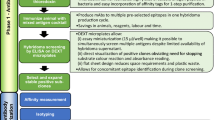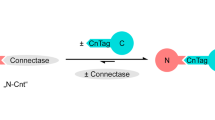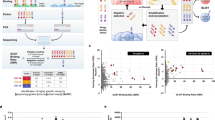Abstract
Post-translational modifications alter protein structure, affecting activity, stability, localization and/or binding partners. Antibodies that specifically recognize post-translationally modified proteins have a number of uses including immunocytochemistry and immunoprecipitation of the modified protein to purify protein-protein and protein-nucleic acid complexes. However, antibodies directed at modified sites on individual proteins are often nonspecific. Here we describe a protocol to purify polyclonal antibodies that specifically detect the modified protein of interest. The approach uses iterative rounds of subtraction and affinity purification, using stringent washes to remove antibodies that recognize the unmodified protein and low sequence complexity epitopes containing the modified amino acid. Dot blot and western blot assays are used to assess antibody preparation specificity. The approach is designed to overcome the common occurrence that a single round of subtraction and affinity purification is not sufficient to obtain a modified protein-specific antibody preparation. One full round of antibody purification and specificity testing takes 6 d of discontinuous time.
This is a preview of subscription content, access via your institution
Access options
Subscribe to this journal
Receive 12 print issues and online access
$259.00 per year
only $21.58 per issue
Buy this article
- Purchase on Springer Link
- Instant access to full article PDF
Prices may be subject to local taxes which are calculated during checkout









Similar content being viewed by others
References
Cleghon, V. et al. Opposing actions of CSW and RasGAP modulate the strength of Torso RTK signaling in the Drosophila terminal pathway. Mol. Cell 2, 719–727 (1998).
Cleghon, V. et al. Drosophila terminal structure development is regulated by the compensatory activities of positive and negative phosphotyrosine signaling sites on the Torso RTK. Genes Dev. 10, 566–577 (1996).
Cutler, R.E. Jr. & Morrison, D.K. Mammalian Raf-1 is activated by mutations that restore Raf signaling in Drosophila. EMBO J. 16, 1953–1960.
Deem, A.K., Li, X. & Tyler, J.K. Epigenetic regulation of genomic integrity. Chromosoma 121, 131–151.
Gao, J.J. et al. The proteasome regulates bacterial CpG DNA-induced signaling pathways in murine macrophages. Shock 34, 390–401.
Gayko, U., Cleghon, V., Copeland, T., Morrison, D.K. & Perrimon, N. Synergistic activities of multiple phosphotyrosine residues mediate full signaling from the Drosophila Torso receptor tyrosine kinase. Proc. Natl. Acad. Sci. USA 96, 523–528 (1999).
Hsu, V., Zobel, C.L., Lambie, E.J., Schedl, T. & Kornfeld, K. Caenorhabditis elegans lin-45 raf is essential for larval viability, fertility and the induction of vulval cell fates. Genetics 160, 481–492 (2002).
Jacobs, D., Beitel, G.J., Clark, S.G., Horvitz, H.R. & Kornfeld, K. Gain-of-function mutations in the Caenorhabditis elegans lin-1 ETS gene identify a C-terminal regulatory domain phosphorylated by ERK MAP kinase. Genetics 149, 1809–1822 (1998).
Kaplan, D.R., Morrison, D.K., Wong, G., McCormick, F. & Williams, L.T. PDGF-β-receptor stimulates tyrosine phosphorylation of GAP and association of GAP with a signaling complex. Cell 61, 125–133 (1990).
Kornfeld, K., Hom, D.B. & Horvitz, H.R. The ksr-1 gene encodes a novel protein kinase involved in Ras-mediated signaling in C. elegans. Cell 83, 903–913 (1995).
Lackner, M.R., Kornfeld, K., Miller, L.M., Horvitz, H.R. & Kim, S.K. A MAP kinase homolog, mpk-1, is involved in ras-mediated induction of vulval cell fates in Caenorhabditis elegans. Genes Dev. 8, 160–173 (1994).
Mason, J.M., Morrison, D.J., Basson, M.A. & Licht, J.D. Sprouty proteins: multifaceted negative-feedback regulators of receptor tyrosine kinase signaling. Trends Cell Biol. 16, 45–54.
Morrison, D.K. & Davis, R.J. Regulation of MAP kinase signaling modules by scaffold proteins in mammals. Annu. Rev. Cell Dev. Biol. 19, 91–118.
Ohsawa, R., Adkins, M. & Tyler, J.K. Epigenetic inheritance of an inducibly nucleosome-depleted promoter and its associated transcriptional state in the apparent absence of transcriptional activators. Epigenetics Chromatin 2, 11 (2009).
Ory, S. & Morrison, D.K. Signal transduction: implications for Ras-dependent ERK signaling. Curr. Biol. 14, R277–R278 (2004).
Ory, S., Zhou, M., Conrads, T.P., Veenstra, T.D. & Morrison, D.K. Protein phosphatase 2A positively regulates Ras signaling by dephosphorylating KSR1 and Raf-1 on critical 14-3-3 binding sites. Curr. Biol. 13, 1356–1364 (2003).
Ritt, D.A., Monson, D.M., Specht, S.I. & Morrison, D.K. Impact of feedback phosphorylation and Raf heterodimerization on normal and mutant B-Raf signaling. Mol. Cell Biol. 30, 806–819 (2010).
Shen, J. et al. Key inflammatory signaling pathways are regulated by the proteasome. Shock 25, 472–484 (2006).
Jud, M.C. et al. Large P body-like RNPs form in C. elegans oocytes in response to arrested ovulation, heat shock, osmotic stress, and anoxia and are regulated by the major sperm protein pathway. Dev. Biol. 318, 38–51 (2008).
Liu, T. et al. Broad chromosomal domains of histone modification patterns in C. elegans. Genome Res. 21, 227–236 (2011).
Mikeladze-Dvali, T. et al. Analysis of centriole elimination during C. elegans oogenesis. Development 139, 1670–1679 (2012).
Logan, C.Y. & Nusse, R. The Wnt signaling pathway in development and disease. Annu. Rev. Cell Dev. Biol. 20, 781–810.
Argenzio, E. et al. Proteomic snapshot of the EGF-induced ubiquitin network. Mol. Syst. Biol. 7, 462.
Blagoev, B. et al. A proteomics strategy to elucidate functional protein-protein interactions applied to EGF signaling. Nat. Biotechnol. 21, 315–318 (2003).
Pandey, A. et al. Analysis of receptor signaling pathways by mass spectrometry: identification of vav-2 as a substrate of the epidermal and platelet-derived growth factor receptors. Proc. Natl. Acad. Sci. USA 97, 179–184 (2000).
Schulze, W.X., Deng, L. & Mann, M. Phosphotyrosine interactome of the ErbB-receptor kinase family. Mol. Syst. Biol. 1, 2005.0008 (2005).
Arur, S. et al. MPK-1 ERK controls membrane organization in C. elegans oogenesis via a sex-determination module. Dev. Cell 20, 677–688 (2011).
Arur, S. et al. Multiple ERK substrates execute single biological processes in Caenorhabditis elegans germ-line development. Proc. Natl. Acad. Sci. USA 106, 4776–4781 (2009).
Kraus, S. & Seger, R. Determination of ERK activity: antiphospho-ERK antibodies, in vitro phosphorylation, and in-gel kinase assay. Methods Mol. Biol. 250, 29–48 (2004).
Kumar, J.P. et al. Dissecting the roles of the Drosophila EGF receptor in eye development and MAP kinase activation. Development 125, 3875–3885 (1998).
Perlson, E. et al. Vimentin-dependent spatial translocation of an activated MAP kinase in injured nerve. Neuron 45, 715–726 (2005).
Wortzel, I. & Seger, R. The ERK cascade: distinct functions within various subcellular organelles. Genes Cancer 2, 195–209 (2011).
Yao, Z. et al. Detection of partially phosphorylated forms of ERK by monoclonal antibodies reveals spatial regulation of ERK activity by phosphatases. FEBS Lett. 468, 37–42 (2000).
Chuderland, D. & Seger, R. Calcium regulates ERK signaling by modulating its protein-protein interactions. Commun. Integr. Biol. 1, 4–5 (2008).
Hadwiger, G., Dour, S., Arur, S., Fox, P. & Nonet, M.L. A monoclonal antibody toolkit for C. elegans. PLoS ONE 5, e10161 (2010).
Rubinfeld, H. & Seger, R. The ERK cascade as a prototype of MAPK signaling pathways. Methods Mol. Biol. 250, 1–28 (2004).
Shaul, Y.D. & Seger, R. The MEK/ERK cascade: from signaling specificity to diverse functions. Biochim. Biophys. Acta 1773, 1213–1226 (2007).
Wolf, I. et al. Involvement of the activation loop of ERK in the detachment from cytosolic anchoring. J. Biol. Chem. 276, 24490–24497 (2001).
Yao, Z. & Seger, R. The ERK signaling cascade--views from different subcellular compartments. Biofactors 35, 407–416 (2009).
Zehorai, E., Yao, Z., Plotnikov, A. & Seger, R. The subcellular localization of MEK and ERK--a novel nuclear translocation signal (NTS) paves a way to the nucleus. Mol. Cell Endocrinol. 314, 213–220 (2010).
Friedman, A. & Perrimon, N. A functional RNAi screen for regulators of receptor tyrosine kinase and ERK signalling. Nature 444, 230–234 (2006).
Ahn, N.G., Seger, R., Bratlien, R.L. & Krebs, E.G. Growth factor-stimulated phosphorylation cascades: activation of growth factor-stimulated MAP kinase. Ciba Found. Symp. 164, 113–126 (1992).
Alberola-Ila, J., Forbush, K.A., Seger, R., Krebs, E.G. & Perlmutter, R.M. Selective requirement for MAP kinase activation in thymocyte differentiation. Nature 373, 620–623 (1995).
Gabay, L., Seger, R. & Shilo, B.Z. MAP kinase in situ activation atlas during Drosophila embryogenesis. Development 124, 3535–3541 (1997).
Harris, D. et al. Activation of MAPK cascades by GnRH: ERK and Jun N-terminal kinase are involved in basal and GnRH-stimulated activity of the glycoprotein hormone LH-subunit promoter. Endocrinology 143, 1018–1025 (2002).
Egelhofer, T.A. et al. An assessment of histone-modification antibody quality. Nat. Struct. Mol. Biol. 18, 91–93 (2011).
Xie, C., Liang, Z., Chang, S. & Mohan, C. Use of a novel elution regimen reveals the dominance of polyreactive antinuclear autoantibodies in lupus kidneys. Arthritis Rheum. 48, 2343–2352 (2003).
Goto, H. & Inagaki, M. Production of a site- and phosphorylation state-specific antibody. Nat. Protoc. 2, 2574–2581 (2007).
Ayyar, B.V., Arora, S., Murphy, C. & O'Kennedy, R. Affinity chromatography as a tool for antibody purification. Methods 56, 116–129 (2012).
Ross, A.H., Baltimore, D. & Eisen, H.N. Phosphotyrosine-containing proteins isolated by affinity chromatography with antibodies to a synthetic hapten. Nature 294, 654–656 (1981).
Nairn, A.C., Detre, J.A., Casnellie, J.E. & Greengard, P. Serum antibodies that distinguish between the phospho- and dephospho-forms of a phosphoprotein. Nature 299, 734–736 (1982).
Boldicke, T. et al. A new peptide-affinity tag for the detection and affinity purification of recombinant proteins with a monoclonal antibody. J. Immunol. Methods 240, 165–183 (2000).
Cook, C., Hazen, B. & Pang, D. Luer tip quick antibody purification by affinity chromatography. Am. Biotechnol. Lab. 8, 16–18 (1990).
Dansithong, W., Paul, S., Kojima, Y., Kamiya, K. & Shinozawa, T. A simple method for midkine purification by affinity chromatography with a heavy chain variable domain (VH) fragment of antibody. J. Biochem. Biophys. Methods 48, 77–84 (2001).
Hocking, G.R. et al. Lymphocyte fluorescence polarization changes after phytohemagglutinin stimulation in the diagnosis of colorectal carcinoma. J. Natl. Cancer Inst. 68, 579–583 (1982).
Kreutz, F.T., Wishart, D.S. & Suresh, M.R. Efficient bispecific monoclonal antibody purification using gradient thiophilic affinity chromatography. J. Chromatogr. B. Biomed. Sci. Appl. 714, 161–170 (1998).
Czernik, A.J. et al. Production of phosphorylation state-specific antibodies. Methods Enzymol. 201, 264–283 (1991).
Meggio, F., Perich, J.W., Reynolds, E.C. & Pinna, L.A. A synthetic β-casein phosphopeptide and analogues as model substrates for casein kinase-1, a ubiquitous, phosphate directed protein kinase. FEBS Lett. 283, 303–306 (1991).
Meggio, F., Perich, J.W., Reynolds, E.C. & Pinna, L.A. Phosphotyrosine as a specificity determinant for casein kinase-2, a growth related Ser/Thr-specific protein kinase. FEBS Lett. 279, 307–309 (1991).
Perich, J.W. Synthesis of O-phosphoserine- and O-phosphothreonine-containing peptides. Methods Enzymol. 201, 225–233 (1991).
Perich, J.W. Synthesis of O-phosphotyrosine-containing peptides. Methods Enzymol 201, 234–245 (1991).
Saez, J.C. et al. Phosphorylation of connexin43 and the regulation of neonatal rat cardiac myocyte gap junctions. J. Mol. Cell Cardiol. 29, 2131–2145 (1997).
Archuleta, A.J., Stutzke, C.A., Nixon, K.M. & Browning, M.D. Optimized protocol to make phospho-specific antibodies that work. Methods Mol. Biol. 717, 69–88 (2011).
Blanquet, P.R., Mariani, J. & Fournier, B. Temporal assessment of histone H3 phospho-acetylation and casein kinase 2 activation in dentate gyrus from ischemic rats. Brain Res. 1302, 10–20 (2009).
Veras, E., Malpica, A., Deavers, M.T. & Silva, E.G. Mitosis-specific marker phospho-histone H3 in the assessment of mitotic index in uterine smooth muscle tumors: a pilot study. Int. J. Gynecol. Pathol. 28, 316–321 (2009).
Tapia, C. et al. Two mitosis-specific antibodies, MPM-2 and phospho-histone H3 (Ser28), allow rapid and precise determination of mitotic activity. Am. J. Surg. Pathol. 30, 83–89 (2006).
Burks, E.A., Chen, G., Georgiou, G. & Iverson, B.L. In vitro scanning saturation mutagenesis of an antibody binding pocket. Proc. Natl. Acad. Sci. USA 94, 412–417 (1997).
Davies, J. & Riechmann, L. Affinity improvement of single antibody VH domains: residues in all three hypervariable regions affect antigen binding. Immunotechnology 2, 169–179 (1996).
Davies, J. & Riechmann, L. Single antibody domains as small recognition units: design and in vitro antigen selection of camelized, human VH domains with improved protein stability. Protein Eng. 9, 531–537 (1996).
McGinnis, S. & Madden, T.L. BLAST: at the core of a powerful and diverse set of sequence analysis tools. Nucleic Acids Res. 32, W20–W25 (2004).
Schall, C.A. & Wiencek, J.M. Stability of nicotinamide adenine dinucleotide immobilized to cyanogen bromide activated agarose. Biotechnol. Bioeng. 53, 41–48 (1997).
Bollin, E. Jr. & Sulkowski, E. Physico-chemical characterization of hamster interferon. Prep. Biochem. 9, 339–358 (1979).
Werber, M.M. Nucleophilicity of isourea linkages in substituted agaroses. A direct method for the determination of alkylamino groups coupled to CNBr-activated agarose. Anal. Biochem. 76, 177–183 (1976).
Wilchek, M., Oka, T. & Topper, Y.J. Structure of a soluble super-active insulin is revealed by the nature of the complex between cyanogen-bromide-activated Sepharose and amines. Proc. Natl. Acad. Sci. USA 72, 1055–1058 (1975).
Bernatowicz, M.S., Matsueda, R. & Matsueda, G.R. Preparation of Boc-[S-(3-nitro-2-pyridinesulfenyl)]-cysteine and its use for unsymmetrical disulfide bond formation. Int. J. Pept. Protein Res. 28, 107–112 (1986).
Bernatowicz, M.S. & Matsueda, G.R. Preparation of peptide-protein immunogens using N-succinimidyl bromoacetate as a heterobifunctional crosslinking reagent. Anal. Biochem. 155, 95–102 (1986).
Ejima, D., Yumioka, R., Tsumoto, K. & Arakawa, T. Effective elution of antibodies by arginine and arginine derivatives in affinity column chromatography. Anal. Biochem. 345, 250–257 (2005).
Karim, A.S., Johansson, C.S. & Weltman, J.K. Maleimide-mediated protein conjugates of a nucleoside triphosphate -S and an internucleotide phosphorothioate diester. Nucleic Acids Res. 23, 2037–2040 (1995).
Taipa, M.A., Kaul, R.H., Mattiasson, B. & Cabral, J.M. Recovery of a monoclonal antibody from hybridoma culture supernatant by affinity precipitation with Eudragit S-100. Bioseparation 9, 291–298 (2000).
Meldrum, N.U. & Tarr, H.L. The reduction of glutathione by the Warburg-Christian system. Biochem. J. 29, 108–115 (1935).
Walker, J.M. The bicinchoninic acid (BCA) assay for protein quantitation. Methods Mol. Biol. 32, 5–8 (1994).
Sambrook, J. & Russell, D.W. The Condensed Protocols from Molecular Cloning: A Laboratory Manual (Cold Spring Harbor Laboratory Press, 2006).
Boag, P.R., Nakamura, A. & Blackwell, T.K. A conserved RNA-protein complex component involved in physiological germline apoptosis regulation in C. elegans. Development 132, 4975–4986 (2005).
Navarro, R.E. & Blackwell, T.K. Requirement for P granules and meiosis for accumulation of the germline RNA helicase CGH-1. Genesis 42, 172–180 (2005).
Acknowledgements
Work in the T.S. laboratory on this project was supported by National Science Foundation grant no. 0416502 and US National Institutes of Health (NIH) grant no. GM085150. Work in S.A.'s laboratory on this project was supported by NIH grant no. GM98200, an Institutional Research Grant from a Cancer Center Supplemental Grant (CCSG) to The University of Texas M.D. Anderson Cancer Center and the Center for Genetics and Genomics, The University of Texas M.D. Anderson Cancer Center. We thank A. Golden (NIH/National Institute of Diabetes and Digestive and Kidney Diseases (NIDDK)), D. Greenstein (University of Minnesota) and C. Spike (University of Minnesota) for extensive comments on the manuscript.
Author information
Authors and Affiliations
Contributions
S.A. and T.S. designed, implemented and wrote the protocol.
Corresponding authors
Ethics declarations
Competing interests
The authors declare no competing financial interests.
Rights and permissions
About this article
Cite this article
Arur, S., Schedl, T. Generation and purification of highly specific antibodies for detecting post-translationally modified proteins in vivo. Nat Protoc 9, 375–395 (2014). https://doi.org/10.1038/nprot.2014.017
Published:
Issue Date:
DOI: https://doi.org/10.1038/nprot.2014.017
This article is cited by
-
GRAF1 integrates PINK1-Parkin signaling and actin dynamics to mediate cardiac mitochondrial homeostasis
Nature Communications (2023)
-
Glucose-driven TOR–FIE–PRC2 signalling controls plant development
Nature (2022)
-
Epitope-directed monoclonal antibody production using a mixed antigen cocktail facilitates antibody characterization and validation
Communications Biology (2021)
-
Site-selective protein-modification chemistry for basic biology and drug development
Nature Chemistry (2016)
-
Novel method for the high-throughput production of phosphorylation site-specific monoclonal antibodies
Scientific Reports (2016)
Comments
By submitting a comment you agree to abide by our Terms and Community Guidelines. If you find something abusive or that does not comply with our terms or guidelines please flag it as inappropriate.



